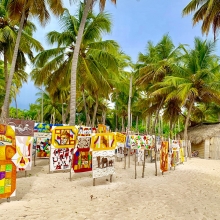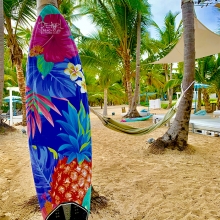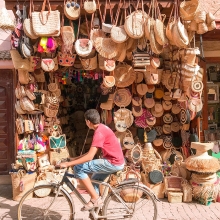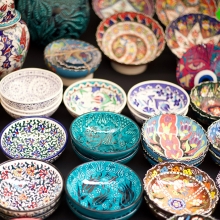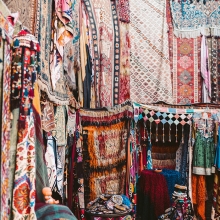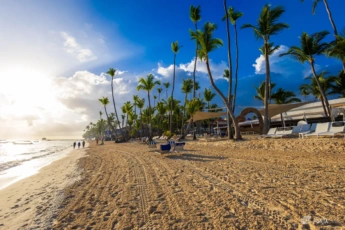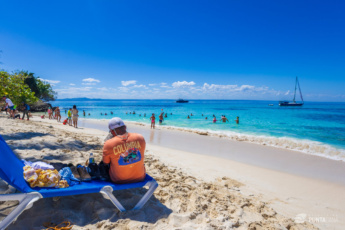Souvenirs from the Dominican Republic – What to Buy in 2025?
The tropical Dominican Republic can’t leave without positive emotions. Tourists are surrounded by the bright colors of the Caribbean Sea, sky and green palms; taste buds enjoy rum cocktails and exotic fruit juices; the sound of the sea and the sounds of merengue are mellifluous. How to share this tropical idyll with friends? Bring colorful souvenirs and gifts!
To make gifts from this country look like a real Caribbean exotic, and not remind you of factory Chinese production, we have compiled for you a list of the best souvenirs from the Dominican Republic to bring back as a gift.
1. Small gifts: lime-dolls, larimar stone and shark-amulets

Dominican souvenirs – Larimar
An original souvenir that can be brought from the Dominican Republic will be faceless dolls – Lime. In the Dominican Republic, these unusual dolls are beautifully decorated, but without faces. Some tourists are afraid of these dolls, considering them a variation on voodoo dolls from the neighboring country of Haiti.
But Dominican dolls are just a tribute to the local culture, which is a mix of peoples: aborigines, Spaniards, Africans. Lime dolls usually hold a basket or a bunch of flowers in their hands. Basically, dolls are made from a special material – cold porcelain, but there are also less fragile specimens from clay and cornmeal. They cost from $3.
A unique souvenir from the Dominican Republic is the larimar stone. The blue gem is often called the Dominican miracle. The uniqueness of the generally inexpensive stone is that it is mined only in the Dominican Republic. The world’s only larimar mine is located in the area of the city of Barahona. Most often, the stone is framed with silver, the most beautiful specimens – with gold. The most valuable is considered to be a dark blue stone, as over time the larimar loses its color. Silver jewelry starts at $10 in markets.
As small gifts from the DR, you can also bring:
- Seashells and starfish souvenirs. They cost from $1.
- Crafts from coconut shells. It can be dishes, decorative crafts, magnets, amulets.
- Paintings by local artists. The minimum price for works by Dominican artists is $5. Basically, the paintings depict seascapes, portraits of colorful personalities, settlements of local residents.
- Painted plates. Local plates differ from Chinese ones in original ornaments. There are not only round but also square specimens. The average cost of a souvenir plate is $3.
- Shark amulets. Amulets are made from shark teeth. Perhaps this is the most original of the budget souvenirs to bring from the Dominican Republic as a gift. Prices for shark amulets start from a few dollars. It is believed that such an amulet has strong shark energy and brings good luck to the owner.
- Handmade carpets. Dominican rugs are colorful, woven from the coarse pile. They are not distinguished by sophistication, but they fit well into interiors in ethnic style.
Keep all receipts for souvenirs! They may be requested at the airport.
2. Dominican coffee: “Santo Domingo” and “Barahona”

Dominican coffee – Santo Domingo
Coffee, strong and sweet, is the favorite drink of the Dominicans. Everywhere you can find residents relaxing with a cup of coffee or with a thermos filled with a hot drink for the whole day. Local Arabica grown on plantations in the vicinity of the cities of Barahona, Cibao, Okoa and Bani has a mild taste without the characteristic bitterness.
Another advantage of local coffee is that 90% of all Dominican coffee is grown in environmentally friendly conditions, without the use of chemicals and pesticides. Dominican coffee is grown on small farms, which excludes low-quality conveyor production. This coffee is called organic.
The most popular coffee in the Dominican Republic is Santo Domingo. Despite the name, coffee is not grown in the capital, but in the highlands. Santo Domingo coffee is sold under different brands. Beans are medium roasted but taste like dark roasted coffee. The taste of “Santo Domingo” has chocolate and nutty notes with a light, delicate acidity. This coffee is an inexpensive and practical variant to bring home and friends from the Dominican Republic.
Have you brought coffee and don’t know how to make it?
The traditional way of brewing Dominican coffee. Take 2 teaspoons of finely ground coffee, add sweetened water, nutmeg (to taste) and let it brew for 2-3 minutes. Then the coffee has to be passed through a fabric filter, add milk.
Among the varieties of coffee “Santo Domingo” worth trying:
- Induban Gourmet – has a soft creamy taste. The complex floral-vanilla aftertaste of this coffee is appreciated all over the world.
- Cafe Pilon. This type of coffee grows in an area surrounded by vegetation with a high content of essential oils. Due to this, the coffee has an extraordinary aroma of spices and tea rose. There is practically no traditional bitterness, in the aftertaste – citrus sourness.
- Cafe Tinto. The wine name of coffee was not given by chance – the wine-fruity aroma is clearly felt. On the palate – berry notes.
- Santo Domingo Aroma. The coffee is not grown in high altitude areas like the original Santo Domingo. Therefore, it has a less tart and rich flavor. There are notes of chocolate and dark fruits.
- Blasercafe Ocoa Santo Domingo. Coffee is devoid of acidity. It has a spicy, peppery taste with hints of chocolate. The drink is very invigorating due to its higher caffeine content.
The second most popular coffee in the Dominican Republic, after Santo Domingo, is Barahona. The acidity of the drink made from Barahona beans is very low, the taste is based on chocolate-prune notes, there are also tones of caramel, tobacco and nuts. Coffee “Monte Alto” produces a special series for coffee machines called “Espresso”.
Prices for coffee in the Dominican Republic
The exact price depends on the type of coffee. On average, 100 grams of roasted beans will cost $2-3. A package of ground coffee weighing 450 grams will cost from $8-10. Do-it-yourself green beans can be purchased for $17–20.
3. Dominican cocoa: cocoa balls and powder
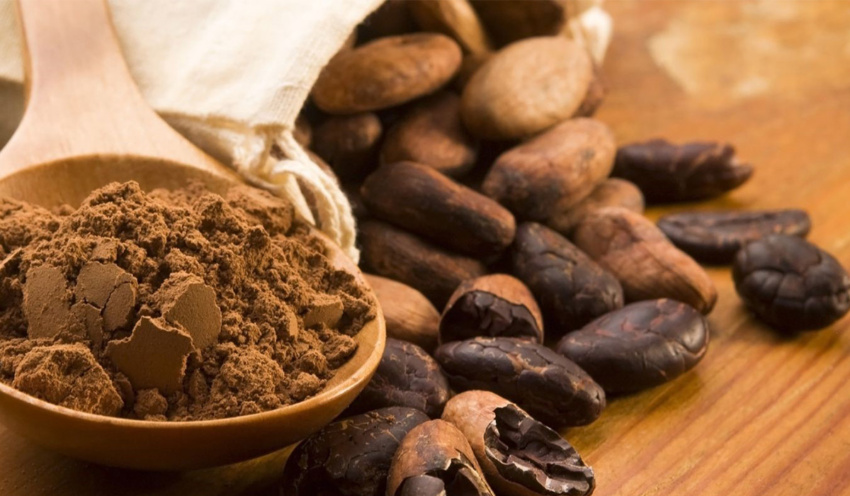
Dominican cocoa
In the Dominican Republic, cocoa balls are sold. These balls are obtained from cocoa beans (dried, roasted and crushed) mixed with sugar, vanilla, cinnamon and other spices. Sometimes red pepper is added to the mass. The cost of one ball of cocoa is about $1, cans (10 pieces) – from $5.
How to make Dominican cocoa balls?
The balls are grated and poured with hot milk. The optimal ratio per cup is 200 ml milk and one cocoa ball. In these proportions, you get a cup of delicious cocoa “like from childhood”. If you want a richer drink that looks more like hot chocolate than cocoa, then you should use 2 cocoa balls. You can use water instead of milk – but then the drink should be brought to a boil. You can make it thicker by replacing milk with cream.
Also, in the Dominican Republic there are cocoa powder. A package of local cocoa weighing 250 grams will cost $5. Chocolate bars with a high content of natural cocoa beans cost from $2-3.
4. Dominican cosmetics: vegetable oils and extracts

Dominican cosmetics from coconut oil
In tourist shops, most cosmetics are offered with low-quality composition – silicone, alcohol. Pay attention to the expiration date – for natural cosmetics it should be short. In reviews of what souvenirs from the DR to bring, tourists recommend purchasing cosmetics in shopping centers for locals. The basis of Dominican cosmetics is vegetable oils, animal fats and various extracts. The most popular among our compatriots are:
- Cream on the basis of snail mucus “Baba de Caracol”. The range of creams includes hair care products that accelerate growth and promote rapid cell regeneration; face creams with a rejuvenating effect.
- Products with cocoa butter. The oil is used to moisturize dry skin and to rejuvenate. There are products for hair, face and body, lip balms.
- Coconut oil. In its pure form, tourists use it to get an even tan. In creams – to moisturize the skin. A small 220 ml bottle of coconut oil costs between $3-5. Look for bottles labeled Virgin Coconut Oil.
- Cream with whale spermaceti. The anti-aging cream is a favorite of local women, whose skin remains elastic and taut for a long time. According to reviews, the cream has a cumulative effect – with prolonged use, wrinkles are significantly smoothed out. A jar of 57 grams will cost from $30-40.
- Cream with noni fruit extract. The cream has a lifting effect and gives the skin a matte finish. Costs from $20.
Anti-cellulite scrubs with coffee beans, sea salt and cane sugar are popular. As small souvenirs, you can buy coconut oil soap or black soap made from bananas.
5. Dominican fruits: mango, avocado, limonsillo, noni, anona
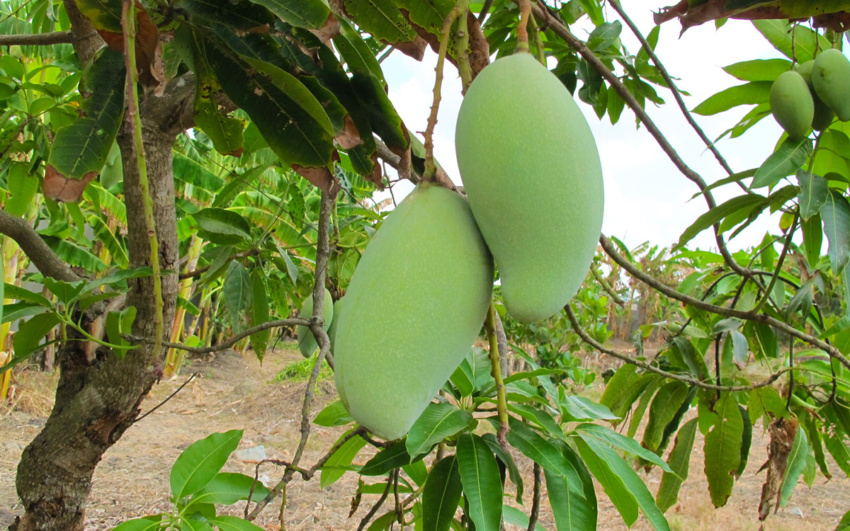
Dominican mango tree
The average annual temperature in the DR is +26 degrees, so fresh fruits are available here all year round. Here grow:
- Oranges. They are used in the DR only for juice. Dominicans add sugar and ice to freshly squeezed juice.
- Mango. The fruit was imported from India, but took root well. Now in the Dominican Republic there are more than a hundred different varieties.
- Avocado. The Dominican avocado is larger than what we are used to, its flesh is very soft, creamy.
- Passion fruit. The small sour fruit is ideal for transportation.
- Pineapples. Pineapples in the Dominican Republic are sweet and juicy.
- Carambola. When cut, the fruit looks like a star, can be used to decorate desserts.
- Limonsillo. Sold by twigs that look like grapes. The pulp is located under the thin skin, perfectly quenches thirst.
- Noni. The fruit that smells like a musty cheese is incredibly healthy, and its extracts are used to fight cancer.
- Anona. The fruit looks like a 10 cm long cone. Under the peel there is a delicate pulp that tastes like custard.
The average cost of 1 kg of fruit is $1. There are no restrictions on the export of fruits. How to bring fruits from the Dominican Republic? It is better to use plastic baskets for transportation. They are checked in with the suitcase.
6. Dominican cigars: Arturo Fuente and Courvoisier
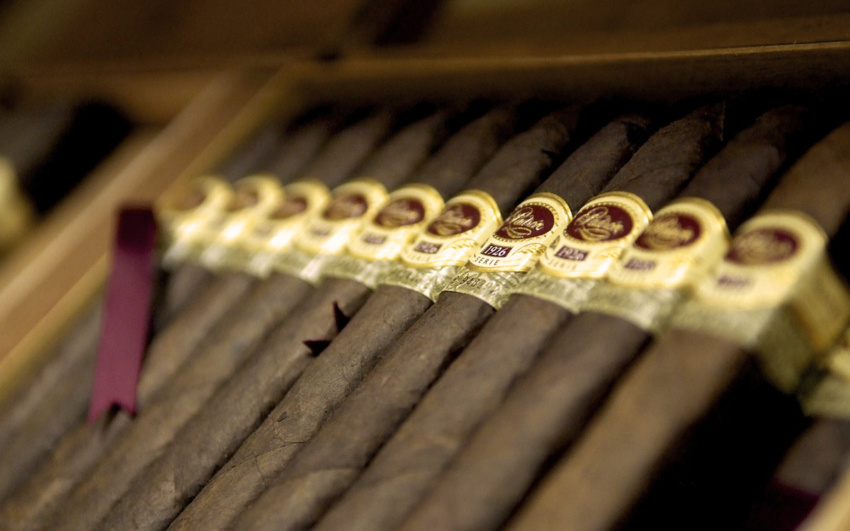
Dominican cigars
The most “masculine” gift that you can bring from the Dominican Republic is cigars. Most of the cigars in the Dominican Republic are handmade. They consist of three parts: the wrapper, the filler, and the binder. Cigars can be of two shapes: parejos (straight, cylindrical) and figurados (not straight, curly shapes). There are several sizes of cigars:
- Small: 100-106 mm in length.
- Medium: up to 124 mm.
- Large: up to 194 mm.
The taste, aroma and richness depend on the shape and size, as well as on the diameter of the cigars. All this must be taken into account when choosing cigars from the Dominican Republic as a gift.
Travelers do not recommend buying cigars on the beach – most often the cheapest tobacco wrapped in banana or palm leaves is indicated there. Quality cigars (for example, Arturo Fuente) start at $15 a piece, a small souvenir box of cigars – $50. In addition to Arturo Fuente, there are high quality brands: Davidoff, Courvoisier, Carbonell.
How many cigars can you bring from the DR?
The maximum number of cigars for export is 50 pieces. Tobacco – 250 gr.
It is safer to buy in a store – before purchasing, you can consult with the seller, smell the variant offered, and even taste the most popular types. For a large batch of cigars, you should go to the tobacco factories – they are located in Santo Domingo and La Romana.
By the way, even if you don’t smoke, it is worth bringing a few cigars home. They can be used as an air fragrance. In the manufacture of cigarettes, tobacco leaves are sprayed with various syrups and honey. In the house, the cigar gives a pleasant light aroma of dry tobacco and honey.
What is forbidden to export from the Dominican Republic?
You cannot export the national currency from the Dominican Republic – you will not be able to bring back the local peso as a souvenir. Also prohibited for export: products of animal origin (meat, milk); some types of orchids; independently obtained shells and starfish from the territory of nature reserves; the heart of a palm tree; turtle shells and corals; raw precious and semi-precious stones.
What can tourists bring from the Dominican Republic? Alcohol (it is allowed to export up to 5 liters from the country (source link), but your country may have other restrictions on entry), fruits, coffee and cocoa – in unlimited quantities. If you plan to purchase a lot of alcohol, it is better to take a dry set for “Mama Juan”. It is not subject to restrictions.
We hope this article has formed the idea of what the Dominican Republic is famous for and what souvenirs from Punta Cana, the Dominican Republic you can bring back to your family and friends. We wish you a pleasant stay on the Dominican beaches and productive shopping!
As a conclusion
Bringing home the essence of the Dominican Republic is as delightful as experiencing its vibrant culture firsthand. From unique faceless lime dolls symbolizing the blend of cultures, to exquisite larimar jewelry showcasing the island’s natural beauty, there are countless meaningful souvenirs to choose from. Gourmet items like Dominican coffee and cocoa provide a sensory journey, while tropical fruits bring a taste of the Caribbean to your table. Handcrafted cigars and local cosmetics highlight the country’s rich craftsmanship and natural resources.
Each item embodies the spirit of the Dominican Republic, making them perfect gifts for loved ones or cherished keepsakes of your adventure. While shopping, be mindful of regulations and authenticity to ensure your mementos are truly representative of the region’s charm. With these treasures, you’ll bring home not just objects, but memories of the island’s vibrant life, warmth, and culture.
Updated on: . Author:

